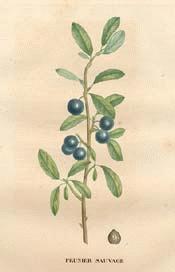
Botanical.com Home Page

|
Bullace
(Prunus insititia)
Click on graphic for larger image
|
Bullace
Botanical: Prunus insititia (LINN.)
Family: N.O. Rosaceae
---Synonyms---Bully-bloom (for the flowers). Bullies, Bolas, Bullions and Wild Damson (for the fruit).
(French) Sibarelles.
---Parts Used---Fruit, wood and bark.
---Habitat---Common in England in thickets, woods and hedges, though more rare in Scotland and probably not wild north of the Forth and Clyde. Common in South-East Europe and in Northern and Central Asia.
---Description---A tall shrub, sometimes developing into a small tree about 15 feet high. Resembles the Blackthorn or Sloe (Prunus spinosa), but is less thorny and has straight, not crooked branches, covered by brown, not black bark, only a few of the old ones terminating in spines, the younger ones downy. It has also larger leaves than the Blackthorn, downy underneath, alternate, finely-toothed, on short, downy foot-stalks, and flowers, white like those of the Blackthorn, but larger, with broader petals, borne in less crowded clusters and not on the naked branches, but expanding just after the leaves have begun to unfold.
The globular, fleshy fruit, marked with a faint suture, has generally a black skin, covered with a thin bluish bloom, and is similar to the Sloe, but larger, often an inch across, and drooping from its weight, not erect as the Sloe. Occasionally yellow varieties are found.
---Constituents---The volatile oil expressed from the seeds contains benzaldehyde and hydrocyanic acid. These substances are also present in the young leaves and flowers.
[Top]
---Medicinal Action and Uses---The bark of the root and branches is considerably styptic. An infusion of the flowers, sweetened with sugar, has been used as a mild purgative for children.
The wood, branches, fruit and entire plant are used throughout France for the same properties as those of the Sloe, the bark of which is used as a febrifuge and the gin, prepared from the fruit on account of its astringency, as a good remedy in cases of diarrhoea.
In this country, the fruit is gathered for 'Bullace Wine,' and is also made into excellent pies and puddings and a good preserve is made by mixing the pulp with three times its weight of sugar.
There are several varieties of the Bullace in cultivation, and they frequently appear on the market as 'Damsons.' Both Bullace and Damson originate from the same source P. domestica, the only difference being that the former is round and the latter oval. All cultivated Bullaces are immense bearers; the following are the best known:
ROYAL BULLACE. Fruit large, 1 1/4 inch in diameter. Skin bright grass-green, mottled with red on the side next to the sun and becoming yellowish-green as it ripens, with a thin, grey bloom on the surface. Flesh green, separating from the stone, briskly flavoured with sufficient sweetness to make it an agreeable late fruit. Ripe in early October.
WHITE BULLACE. Fruit small, round. Skin pale yellowish-white, mottled with red next the sun. Flesh firm, juicy, sub-acid, adhering to the stone, becoming sweetish when quite ripe in end of October and beginning of November. Often sold in London as 'White Damsons .'
ESSEX BULLACE. Skin green, becoming yellowish as it ripens. Flesh juicy and not so acid as the common Bullace. Ripens end of October and beginning of November. Fruit an inch or more in diameter, larger than the common White Bullace.
[Top]
Common Name Index
A MODERN HERBAL Home Page
Bear in mind "A Modern Herbal" was written with the conventional wisdom of the early 1900's. This should be taken into account as some of the information may now be considered inaccurate, or not in accordance with modern medicine.
© Copyright Protected 1995-2025 Botanical.com
|

